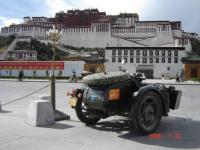
The sidecar is a near-replica of the 1938 BMW R71, passed down from the Soviet copycat Ural M72 and produced in China by the PLA since the mid-1950s. But for enthusiasts like the Bats, the bike is a more than just a collector’s item, writes Mara Hvistendahl for The Walrus:
In the 1990s, the PLA began phasing out the Changjiang, and expatriates in Beijing and Shanghai — “any Western male within shooting distance of a midlife crisis,” one convert wrote in the New York Times — happily acquired them. By the next decade, Chinese men, whose mushrooming bank accounts and increasing free time made them susceptible, had caught up. The Changjiang’s rugged individualism appealed to a culture that had begun to prize Mongolian folk song ring tones, hiking boots on workdays, and, after decades of force-fed socialism, an originality captured in the borrowed term “diy” — do it yourself rather than follow the masses. The Nanchang factory still accepted small custom orders, so aspiring rebels could order their bikes new.
Over lattes, Liu and Frank expound on their obsession. “The sidecar is a way of life for us,” Liu begins. By studying foreign motorcycle sites and imported copies of Iron Horse and Motorcyclist magazines, he has determined that the Changjiang is “our Harley . . . Germany makes bikes, Italy makes bikes, but only the Harley has a history.”
Though their sidecars are more often used for gear than for passengers, the Bats are about human connections, Frank says. Last year, they delivered books to impoverished children in Anhui Province. At November’s Shanghai marathon, they rescued runners with leg cramps, shuttling them to medical stations in their sidecars. The month before, they toured Xinjiang for ten days, befriending Muslim noodle chefs and riding shirtless across the Taklamakan Desert.
Club excursions allow the aging nostalgists, alienated by the fast pace of post-socialist life, to summon up a measure of the country’s comradely past. Changjiangs represent an era when soldiers rode around in friendly pairs; when, as Frank remembers, “everyone left their doors open. You could play in the street with your friends every day. It was the Cultural Revolution, so no one had to go to school.” He gestures to the cold brick buildings outside. “Now everyone closes their doors. Is anyone even happy?”
Photos: Liu Zhidong








